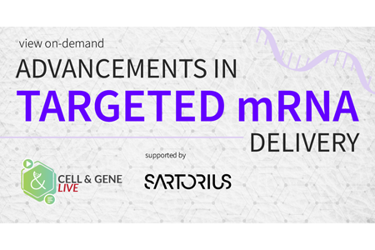Breakdown Of Cell & Gene Live: Advancements In Targeted mRNA Delivery

By Erin Harris, Editor-In-Chief, Cell & Gene
Follow Me On Twitter @ErinHarris_1

During our Cell & Gene Live, Advancements in Targeted mRNA Delivery, Dr. Murat Kalayoglu, CEO of Cartesian Therapeutics, Walter Strapps, Ph.D., Co-Founder and CEO of Carver Biosciences, and I spent the hour talking about the delivery of mRNA-based therapeutics. Our expert panelists discussed the specific challenges and opportunities in delivering conventional RNA therapeutics clinically, as well as the specific challenges and opportunities in delivering the RNA cell therapies clinically. You can view the full-length presentation here. For your convenience, we’ve broken down the hour into bite-size chunks based on the important topics we discussed throughout the hour.
A Better Understanding of mRNA Delivery Challenges
A key challenge to using mRNA-mediated therapeutics extensively across the cell and gene therapy field is how to ensure these particles reach the targeted cell type while prolonging efficacy and maintaining safety. The clinical translation of mRNA therapeutics has been made possible through advances in the design of mRNA manufacturing and intracellular delivery methods. However, broad application of mRNA is still limited by the need for improved delivery systems. In this clip, Strapps level-sets the conversation by providing an understanding of mRNA’s delivery challenges.
The Cell As A Delivery Vehicle
In this clip, Dr. Kalayoglu explains that Cartesian ensures that the cells it administers, and therefore the RNA therapeutics it administers, meet all the specifications the company sets forth in advance. Part of those specifications ensures that there are a certain number of cells that are indeed capable of expressing the RNA into the relevant protein and at certain levels. He explains that they have solved the problem before ever infusing the RNA therapeutic directly into the body, and therefore, the class of therapies Cartesian develops are referred to as RNA cell therapy to distinguish them from conventional RNA therapies, where the RNA is either introduced directly or through the nanoparticle.
In this segment of the presentation, Straps explains that there is a significant history in determining how to deliver all the new plate types; much of the work that made possible the mRNA therapeutics and vaccines goes back to the siRNA space. Most people are relatively familiar with lipid nanoparticles. If you inject a lipid nanoparticle that’s encapsulating a nucleotide, it traffics predominantly to the liver, and it works very robustly. Both Kalayoglu and Strapps cover what’s to come in mRNA delivery.
In perhaps one of the most informative parts of the presentation, Kalayoglu and Strapps provided thoughtful, insightful responses to real-time questions submitted by our audience. To no surprise, our audience submitted solid questions on everything from transecting cells with multiple RNA and the challenges associated with chronic dosing of mRNA therapeutics to the regulatory challenges around mRNA cell therapies. There’s something for everyone in our Q&A segment.
This Cell & Gene Live event was well received and chock full of data. And there’s more where that came from. We deliver Cell & Gene Live presentations on a regular, recurring basis on the cell and gene therapy-related topics our readers care about most. You can learn more about our upcoming Cell & Gene Live presentations, including dates, times, and topics by visiting Cell & Gene, registering for our newsletter, following us on social, or emailing me directly.
